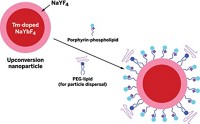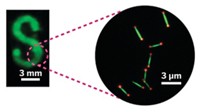Advertisement
Grab your lab coat. Let's get started
Welcome!
Welcome!
Create an account below to get 6 C&EN articles per month, receive newsletters and more - all free.
It seems this is your first time logging in online. Please enter the following information to continue.
As an ACS member you automatically get access to this site. All we need is few more details to create your reading experience.
Not you? Sign in with a different account.
Not you? Sign in with a different account.
ERROR 1
ERROR 1
ERROR 2
ERROR 2
ERROR 2
ERROR 2
ERROR 2
Password and Confirm password must match.
If you have an ACS member number, please enter it here so we can link this account to your membership. (optional)
ERROR 2
ACS values your privacy. By submitting your information, you are gaining access to C&EN and subscribing to our weekly newsletter. We use the information you provide to make your reading experience better, and we will never sell your data to third party members.
Nanomaterials
Making magnetic nanoparticles in a gamut of colors
Colorful polymer particles could enable new diagnostics and electronic devices
by Prachi Patel, special to C&EN
April 8, 2020
| A version of this story appeared in
Volume 98, Issue 14

Using doped polymers, researchers have made magnetic nanoparticles in a rainbow of colors, including white (ACS Appl. Polym. Mater. 2020, DOI: 10.1021/acsapm.0c00038). This broad range of colors has been impossible to achieve with the dark brown iron oxide magnetic nanoparticles used widely today in medical imaging, diagnostic tests, and drug delivery.
These colorful magnetic materials not only could find new biomedical applications but also lead to novel electronic-paper and anti-counterfeiting technologies, says Michinari Kohri, a chemist at Chiba University who led the research.
To make the nanoparticles, Kohri and colleagues turned to holmium, a lanthanide with excellent magnetic properties. The team started by coating 100 nm wide silica nanoparticles with poly(2-acetoacetoxyethyl methacrylate), which forms a brush-like shell around the particles. Then the researchers attached holmium ions to carbonyl groups in the polymer.
The resulting magnetic nanoparticles were white, but the team made colored ones by adding yellow, magenta, or cyan dyes to the polymer coating on the nanoparticles before adding holmium. By mixing those primary colored particles together, the researchers made a whole spectrum of colored nanoparticle blends.
What’s more, “the magnetism can be adjusted by the amount of holmium doped,” Kohri says. When the team placed a magnet next to dispersions of the colored nanoparticles, all the particles collected near the magnet within 5 min. This finding suggests that the particles could be controlled from a distance with stronger magnets, which would be helpful for medical applications where magnetic particles—after they have captured specific biomolecules with the help of functional coatings—need to be guided to specific locations for imaging or testing.
Brightly colored magnetic particles could enable scientists to tag and distinguish multiple biomolecules—viral proteins or disease markers, for example—simultaneously in a tissue or blood sample. The particles could also serve as electronic inks for e-readers, filling tiny capsules controlled by magnetic fields to display various colors. And the white nanoparticles could be applied to novel anti-counterfeiting technologies that rely on printing patterns using magnetic nanoparticle inks. White nanoparticles would be invisible to the eye, unlike current inks.
Tiantian Kong, a mechanical engineer at Shenzhen University, says that the use of holmium, which is not as common as iron oxide, might impact commercial use. Plus, the researchers would have to ensure that the dyes have long-term stability. What stands out most about this research, Kong says, is the development of colorless magnetic particles for which “there could be killer applications.”





Join the conversation
Contact the reporter
Submit a Letter to the Editor for publication
Engage with us on Twitter